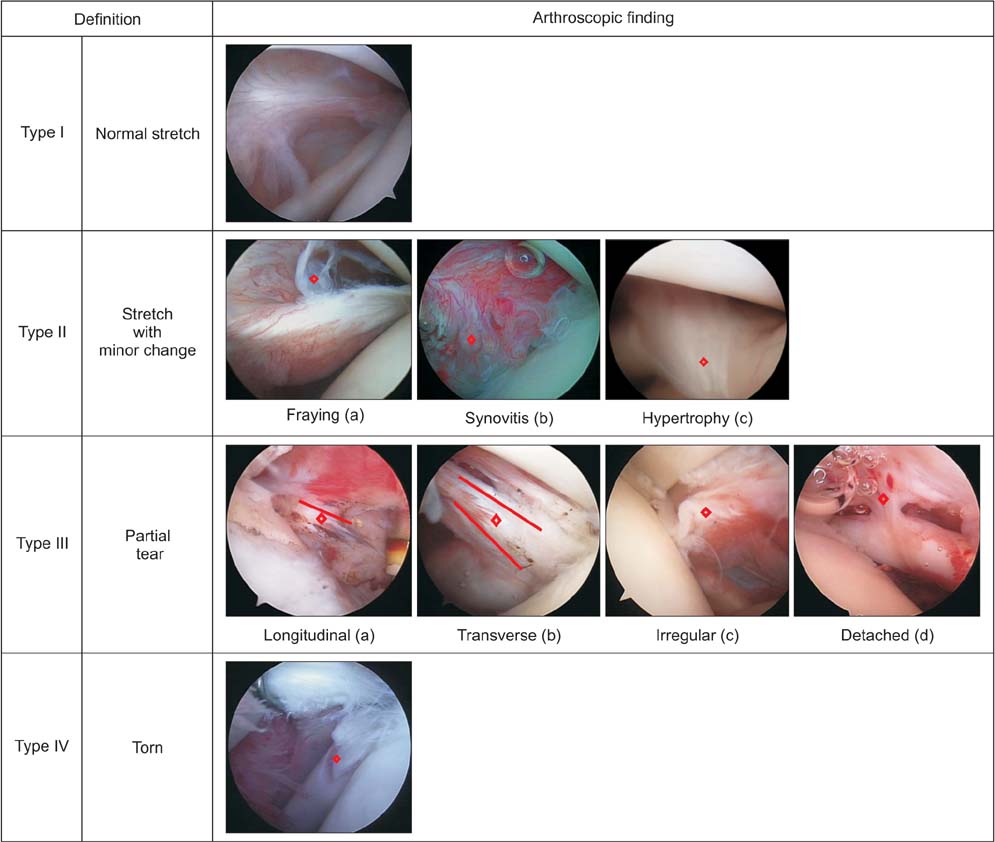Clin Orthop Surg.
2015 Sep;7(3):365-371. 10.4055/cios.2015.7.3.365.
Arthroscopic Changes of the Biceps Pulley in Rotator Cuff Tear and Its Clinical Significance in Relation to Treatment
- Affiliations
-
- 1Department of Orthopaedic Surgery, Daegu Catholic University Medical Center, Daegu, Korea. pearlnet85@naver.com
- KMID: 2234092
- DOI: http://doi.org/10.4055/cios.2015.7.3.365
Abstract
- BACKGROUND
In the case of rotator cuff tears, the biceps pulley can be stressed by the unstable biceps tendon, and this can subsequently affect the stability of the subscapularis tendon. Therefore, it is important to distinguish between normal variations and lesions of the biceps pulley that affect anterosuperior lesions in cases of rotator cuff tears.
METHODS
From January 2002 through November 2010, we observed biceps pulley and associated anterosuperior lesions in 589 of 634 cases (93%) of arthroscopic rotator cuff repair, including 72 cases (12.2%) of small tears, 219 cases (37.2%) of medium tears, 134 cases (22.8%) of large tears, and 164 cases (27.8%) of massive tears. We classified normal stretched biceps pulleys as type I, stretched biceps pulleys with mild changes as type II, those with a partial tear as type III, and torn pulleys as type IV.
RESULTS
We were able to classify 589 cases of biceps pulleys as type I, II, III, or IV associated lesions in rotator cuff tears. Type I was seen in 91 cases (15.4%), type II in 216 cases (36.7%), type III in 157 cases (26.7%), and type IV in 101 cases (17.1%); unidentified cases numbered 24 (4.1%). Nearly three-quarters, 73.3%, of the cases (432/589) had associated anterosuperior lesions, and combined treatment for the associated lesions was administered in 29.2% (172/589) of cases.
CONCLUSIONS
Biceps pulley lesions with more than partial tears were identified in 48% of rotator cuff tear cases. The incidence and severity of pulley lesions were related to the rotator cuff tear size, the status of the long head of the biceps tendon and subscapularis tendon lesion, and the treatment methods.
Keyword
MeSH Terms
Figure
Reference
-
1. Nakata W, Katou S, Fujita A, Nakata M, Lefor AT, Sugimoto H. Biceps pulley: normal anatomy and associated lesions at MR arthrography. Radiographics. 2011; 31(3):791–810.
Article2. Werner A, Mueller T, Boehm D, Gohlke F. The stabilizing sling for the long head of the biceps tendon in the rotator cuff interval: a histoanatomic study. Am J Sports Med. 2000; 28(1):28–31.
Article3. Cooper DE, O'Brien SJ, Arnoczky SP, Warren RF. The structure and function of the coracohumeral ligament: an anatomic and microscopic study. J Shoulder Elbow Surg. 1993; 2(2):70–77.
Article4. Braun S, Horan MP, Elser F, Millett PJ. Lesions of the biceps pulley. Am J Sports Med. 2011; 39(4):790–795.
Article5. Habermeyer P, Magosch P, Pritsch M, Scheibel MT, Lichtenberg S. Anterosuperior impingement of the shoulder as a result of pulley lesions: a prospective arthroscopic study. J Shoulder Elbow Surg. 2004; 13(1):5–12.
Article6. Choi CH, Kim SK, Jang WC, Kim SJ. Biceps pulley impingement. Arthroscopy. 2004; 20:Suppl 2. 80–83.
Article7. Kim HM, Dahiya N, Teefey SA, et al. Location and initiation of degenerative rotator cuff tears: an analysis of three hundred and sixty shoulders. J Bone Joint Surg Am. 2010; 92(5):1088–1096.8. Gerber C, Sebesta A. Impingement of the deep surface of the subscapularis tendon and the reflection pulley on the anterosuperior glenoid rim: a preliminary report. J Shoulder Elbow Surg. 2000; 9(6):483–490.
Article9. Walch G, Nove-Josserand L, Levigne C, Renaud E. Tears of the supraspinatus tendon associated with "hidden" lesions of the rotator interval. J Shoulder Elbow Surg. 1994; 3(6):353–360.
Article
- Full Text Links
- Actions
-
Cited
- CITED
-
- Close
- Share
- Similar articles
-
- Isolated Medial Dislocation of the Long Head of the Biceps without Rotator Cuff Tear: A Case Report
- A Retrospective Analysis of the Relationship Between Rotator Cuff Tear and Biceps Lesion
- Reverse Total Shoulder Arthroplasty in the Massive Rotator Cuff Tear
- Arthroscopic repair of large and massive rotator cuff tears—“sandwich augmentation” with the long head of the biceps tendon: a technical note
- Treatment of Massive Rotator Cuff Tears: Focusing on Arthroscopic Approach


